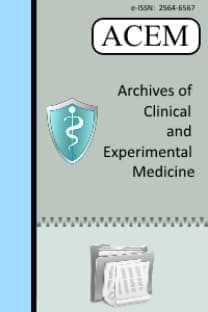Klorin e6’nın Etanol yardımıyla Metisiline Dirençli Stafilokok aureus üzerindeki Fotodinamik Etkisi
Antibakteriyel Fotodinamik Terapi, Klorin e6, Etanol, Stafilokok aureus
Photodynamic action of chlorin e6 against methicillin resistant staphylococcus aureus with the aid of ethanol
___
- Saïd-Salim B, Mathema B, Kreiswirth BN. Community-acquired methicillin-resistant Staphylococcus aureus: an emerging pathogen. Infect Control Hosp Epidemiol. 2003; 24: 451-455.
- Dulon M, Haamann F, Peters C, Schablon A, Nienhaus A. MRSA prevalence in European healthcare settings: a review. BMC Infect Dis. 2011; 11: 138.
- Miller LG, Diep BA. Colonization, fomites, and virulence: rethinking the pathogenesis of community-associated methicillin-resistant Staphylococcus aureus infection. Clin Infect Dis. 2008; 46: 752-760.
- Wenzel RP, Perl TM. The significance of nasal carriage of Staphylococcus aureus and the incidence of postoperative wound infection. J Hosp Infect. 1995; 31: 13-24.
- Kucera J, Sojka M, Pavlik V, Szuszkiewicz K, Velebny V, Klein P. Multispecies biofilm in an artificial wound bed—A novel model for in vitro assessment of solid antimicrobial dressings. J Microbiol Methods. 2014; 103: 18-24.
- Pardoll DM. The blockade of immune checkpoints in cancer immunotherapy. Nat Rev Cancer. 2012; 12: 252-264.
- Khan AA, Morrison A, Hanley DA, Felsenberg D, McCauley LK, O'Ryan F, et al. Diagnosis and management of osteonecrosis of the jaw: a systematic review and international consensus. J Bone Miner Res. 2015; 30: 3-23.
- Tverdek FP, Crank CW, Segreti J. Antibiotic therapy of methicillin-resistant Staphylococcus aureus in critical care. Crit Care Clin. 2008; 24: 249-260.
- Nau R, Eiffert H. Modulation of release of proinflammatory bacterial compounds by antibacterials: potential impact on course of inflammation and outcome in sepsis and meningitis. Clin Microbiol Rev. 2002; 15: 95-110.
- Mai B, Wang X, Liu Q, Leung AW, Wang X, Xu C, et al. The antibacterial effect of sinoporphyrin sodium photodynamic therapy on Staphylococcus aureus planktonic and biofilm cultures. Lasers Surg Med. 2016; 48: 400-408.
- Fu XJ, Fang Y, Yao M. Antimicrobial photodynamic therapy for methicillin-resistant Staphylococcus aureus infection. Biomed Res Int. 2013; 2013.
- Benveniste RAOUL, Davies J. Mechanisms of antibiotic resistance in bacteria. Annu Rev Biochem. 1973; 42: 471-506.
- Klein E, Smith DL, Laxminarayan R. Hospitalizations and deaths caused by methicillin-resistant Staphylococcus aureus, United States, 1999–2005. Emerg Infect Dis. 2007; 13: 1840.
- Lowy, FD. Antimicrobial resistance: the example of Staphylococcus aureus. J Clin Invest. 2003; 111: 1265-1273.
- Lowy FD. Staphylococcus aureus infections. N Engl J Med. 1998; 339: 520-532.
- Peacock Jr JE, Moorman DR, Wenzel RP, Mandell GL. Methicillin-resistant Staphylococcus aureus: microbiologic characteristics, antimicrobial susceptibilities, and assessment of virulence of an epidemic strain. J Infect Dis. 1981; 144: 575-582.
- Yılmaz EŞ, Aslantaş Ö. Antimicrobial resistance and underlying mechanisms in Staphylococcus aureus isolates. Asian Pac J Trop Biomed. 2017; 10: 1059-1064.
- Capparelli R, Parlato M, Borriello G, Salvatore P, Iannelli D. Experimental phage therapy against Staphylococcus aureus in mice. Antimicrob Agents Chemother. 2007; 51: 2765-2773.
- Liu Y, Qin R, Zaat SA, Breukink E, Heger M. Antibacterial photodynamic therapy: overview of a promising approach to fight antibiotic-resistant bacterial infections. J Clin Transl Res. 2015; 1: 140.
- Mai B, Gao Y, Li M, Wang X, Zhang K, Liu Q, et al. Photodynamic antimicrobial chemotherapy for Staphylococcus aureus and multidrug-resistant bacterial burn infection in vitro and in vivo. Int J Nanomedicine. 2017; 12: 5915.
- Čunderlı́ková B, Gangeskar L, Moan J. Acid–base properties of chlorin e6: relation to cellular uptake. J Photochem and Photobiol B. 1999; 53: 81-90.
- Sheyhedin I, Okunaka T, Kato H, Yamamoto Y, Sakaniwa N, Konaka C, Aizawa K. Localization of experimental submucosal esophageal tumor in rabbits by using mono‐L‐aspartyl chlorin e6 and long‐wavelength photodynamic excitation. Lasers in Surgery and Medicine. 2000; 26(1): 83-89.
- George S, Kishen A. Photophysical, photochemical, and photobiological characterization of methylene blue formulations for light-activated root canal disinfection. J Biomed Opt. 2007; 12: 034029.
- Price PB. Reevaluation of ethyl alcohol as a germicide. Arch Surg. 1950; 60: 492-502.
- McDonnell G., Russell AD. Antiseptics and disinfectants: activity, action, and resistance. Clin Microbiol Rev. 1999; 12: 147-179.
- Prochnow EP, Martins MR, Campagnolo CB, Santos RC, Villetti MA, Kantorski KZ. Antimicrobial photodynamic effect of phenothiazinic photosensitizers in formulations with ethanol on Pseudomonas aeruginosa biofilms. Photodiagnosis Photodyn Ther. 2016; 13: 291-296.
- Topaloglu N, Gulsoy M, Yuksel S. Antimicrobial photodynamic therapy of resistant bacterial strains by indocyanine green and 809-nm diode laser. Photomed Laser Surg. 2013;31:155-62.
- ISSN: 2564-6567
- Yayın Aralığı: 3
- Başlangıç: 2016
- Yayıncı: -
Bülent ÇİTGEZ, Elif BARAN, Banu YİĞİT, Soysal BAŞ, Aydın Eray TUFAN, Hamdi ÖZŞAHİN
Bülent ÇİTGEZ, Banu YİĞİT, Soysal BAŞ, Elif BARAN, Aydın Eray TUFAN, Hamdi ÖZŞAHİN
Maşallah BARAN, Yeliz ÇAĞAN APPAK, Betül AKSOY, İsmai̇l SERT, Onur IŞIK, Mehmet Hamdi ÖRÜM, Mustafa ÖZTAN, Muhammet AKYÜZ, Ayşe Berna ANIL, Eyüp KEBABÇI, Tülay KILIÇASLAN AYNA, Yalçın GÜVENLİ, Cem TUĞMEN
Bülent ÇİTGEZ, Elif BARAN, Banu YİĞİT, Soysal BAŞ, Aydın Eray TUFAN, Hamdi ÖZŞAHİN
Ahmet KOKURCAN, Hasan KARADAĞ, Selma ERCAN DOĞU, Funda ERDİ, Sibel ÖRSEL
Plasenta perkreatalı hastaların perinatal sonuçları
Erkan ELCI, Sena SAYAN, GÜlhan ELCI, Numan CIM
Clinical correlates of treatment adherence and insight in patients with schizophrenia
Hasan KARADAĞ, Sibel ÖRSEL, Ahmet KOKURCAN, Selma ERCAN DOĞU, Funda ERDİ
Klorin e6’nın Etanol yardımıyla Metisiline Dirençli Stafilokok aureus üzerindeki Fotodinamik Etkisi
